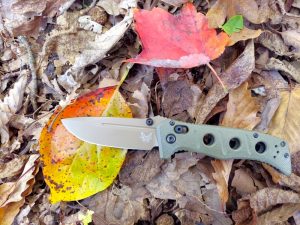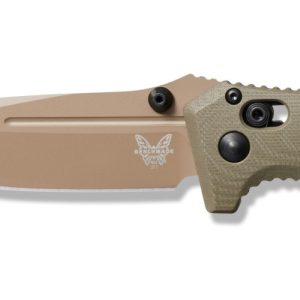The first time I ever saw the Benchmade Mini Adamas, the colors immediately caught my eye. The G10 handle was an Olive Drab color, with the blade color being Flat Dark Earth. It looked seriously nice! And I knew I had to have one.

Benchmade’s Mini Adamas has very cool colors! Photo: Jim Davis.
I ordered one, and before long had the package in my hands. Excitedly, I unboxed my new treasure. Come on, you know the feeling – unboxing a new knife or gun makes you feel like a kid at Christmas, just admit it.
My Precious!
Oh, and it was pretty! The appearance was everything I had hope for.
But alas! A fly pounced into the ointment. There was lock rock. If you don’t know what the means, it is when you open a folding knife and take hold of the blade, and it has play vertically. Basically, it moves around when it should not. When you’re cutting objects, the blade will click up and down in the lock, which is irritating at best. At the worst, it can cause the lock to fail.

There’s nothing more frustrating than experiencing lock issues right out of the box! Photo: Jim Davis.
This was seriously aggravating. Here was a production knife costing upwards of $300, and there was a major flaw in the lock right off the bat. And let me clarify here – Benchmade did not (and refused to) send me a knife to review. I’d requested one and was advised that they do not send writer samples any more. However, I wanted the knife badly enough that I forked over my money and bought it myself.
A Remedy
I placed a call to Benchmade, explaining the problem in detail. They really had a blasé attitude about it, as if they couldn’t have cared less. They did tell me to send it in and they’d fix it up. I explained that I was writing an article on this knife, hoping that we could speed up the process or even have them send a new knife out immediately so that I could get on with things. No dice.
I further explained that this did not look well for their company, since I was writing an article and their knife was not painting a flattering picture so far. They didn’t quite tell me to go “Piss up a rope,”, but it was damn close. They made it abundantly clear that they did not give two shits about the article that was being written about this knife.
So I boxed it up, paid the return postage, and….waited. And waited. And then, I waited a little bit more. Several weeks later, the knife arrived back in the mail.
I’m going to be honest with the readers here – at this point, my view of Benchmade and this knife had taken a serious nose dive in popularity.
The Fix
They did a decent job fixing the knife. It wasn’t as perfectly solid as I’d have liked when it was locked open. But it was certainly solid enough to use. Overall, I’ll say the level to which they fixed the Mini Adamas was acceptable. That said, when compared to the lockup from other knife companies, the Benchmade was still at the bottom of the pile.
Tech Specs
Now that we have that drama out of the way, let’s take a look at the technical specifications of the knife.
Benchmade’s Adamas and Mini Adamas were both designed by gifted knifemaker Shane Sibert.
Blade length is 3.25 inches. Blade thickness is .140 inches. Overall open length is 7.62 inches, and closed length is 4.37 inches. The weight is 4.67 ounces.

The G10 handle is somewhat smooth, which didn’t turn out to be an issue. The Axis lock is easy to work. Photo: Jim Davis.
As mentioned, the handle is G10, and it has a somewhat smooth texture.
And here’s a real factor in the knife’s construction: the blade material is CPM CruWear. It’s a stellar blade steel that keeps an edge for a very long time. Blade design is of the drop point variety, and it’s very nicely shaped.
The carry clip is reversible and can be carried tip up. It’s also a deep carry clip, so not much of the knife protrudes out of the top of the pocket.
The Knife
With all the technical stuff out of the way, how was the knife itself?

The cutouts in the handle serve to both lighten the weight and give the fingertips a place to land. The thumb studs efficiently allow the user to open the knife. Photo: Jim Davis.
It was pretty good, once the repairs were out of the way.
Cutting
Cutting with it was excellent. While the blade is sufficiently thick for this to be an extremely hard-use knife, it was thin enough that it was a very good slicer. It was a decent compromise between being a good slicer and still having sufficient thickness that the blade wasn’t going to snap easily.

While it’s a good idea to have a blade for emergency defense, the knife is far more likely to cut mundane items around the house. Here it is paired with a Glock 43X and a Streamlight. Photo: Jim Davis.
I cut cardboard and plastic with the knife, and it sailed through both mediums. It was also good for cutting fuzz sticks out in the woods. It saw additional use around the house cutting various mundane, everyday items that you’d normally use a knife to cut.
All in all, it’s a good cutter that is not going to dull very quickly. In fact, I never did have to sharpen it.
Handle
The handle shape was also fairly comfortable in use. It wasn’t the most comfortable that I’ve ever used, but it offered good purchase and wasn’t about to slip out of the hand. The G10 wasn’t as grippy as on most knives; rather, it was smooth. This didn’t really prove to be an issue, it’s just an observation.

The Mini Adamas was quite comfortable in the hand, offering a good purchase. Photo: Jim Davis.
The handle is good for both standard grip and also reverse grip.
One useful aspect in the handle are three large cutout holes. Not only do they serve to lighten the knife, but they also allow some traction when the handle is grasped. Also, so users can get their finger tips into those holes, which also enhances the grip.
Thumb Studs
Opening is accomplished via thumb studs that are located on either side of the blade. While they’re not obtrusive, they do a good job of accomplishing their given task. They’re also not uncomfortable for the thumbs to use, as some other knives can be.
Axis Lock
The Mini Adamas locks up via a unique lock, called the Axis Lock. As the blade opens, there is a cutout that a tubular locking mechanism fits into. The tube is propelled into that cutout via a spring. Overall, it works pretty well (when it is properly working), keeping the blade solidly locked open.
To close the knife, I grasped both ends of the lock (with thumb and trigger finger), pulling it back and out of the cutout. At that point, the knife is free to close. If the user holds the knife at an upward angle, the blade will fall closed on its own weight.
With just a little practice, one can become very skilled at closing the blade this way. And if you’re the type who enjoys fidgeting with your knives, you may really love this locking mechanism. It’s rather addicting to open the blade, then drop it closed. Over and over and over.
Overall
What did I think of the knife overall?
It functioned well and cut well. It had a reassuringly solid feel. The steel that is used is a premium steel that promises to give very long edge retention. I can’t testify as to how difficult it is to sharpen because I did not have to, but I’m told by other knife aficionados that it’s not difficult as long as you’re using a diamond hone.

The blade is somewhat thick, yet super-slicey. The CruWear steel holds an edge for a long time. Here is a close look at the Axis lock and how it secures the blade. Photo: Benchmade Knives.
The appearance is a total home run, with the cool colors.
In the end, I was really turned off by Benchmade’s lack of quality control, first of all. And then their pissy attitude toward repairing the knife just turned me off altogether. I have to say, this will likely be the last Benchmade that I purchase because of their attitude toward the customer.
As far as the actual product goes, I understand that there can be lemons. In fact, I’ve gotten lemons from other knife makers in the past, so it certainly does happen. However, most of those other makers cheerfully made it right and made accommodations, whereas Benchmade seemed to only grudgingly do so.
Caveat Emptor.










If it’s anything like the full-size Adamus, I’m all in. Love that knife